Stihl Hedge Trimmer HLA-86 Instruction Manual

Content
Introduction
The Stihl HLA-86 is a high-performance telescopic hedge trimmer designed for both professional landscapers and avid gardeners. This battery-powered tool extends from 260 cm to 330 cm, allowing users to easily trim tall hedges without the need for ladders. Equipped with a 50 cm blade, it offers precision cutting while maintaining a lightweight design of approximately 4.8 kg (6.1 kg with battery). The cost of the Stihl HLA-86 is around $420, excluding the battery.
The information contained in this manual will help you receive maximum performance and satisfaction from your hedge trimmer and, if followed, reduce the risk of injury from its use.
Main Parts
HLA 66 Hedge Trimmer and Battery
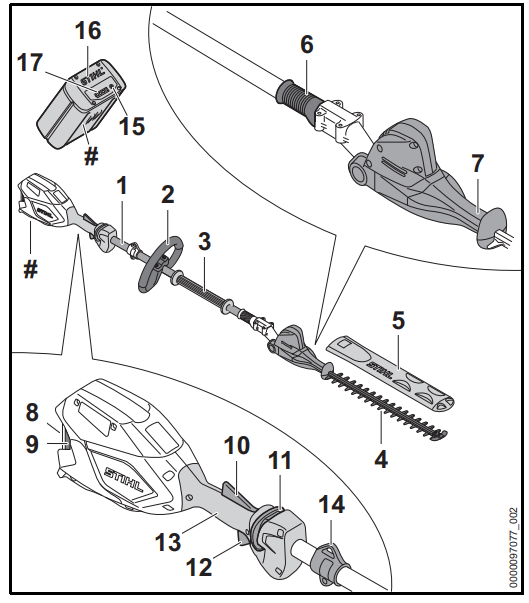
- Drive Tube
Hedge trimmer shaft. - Loop Handle
Handle for the operator's front hand. - Front Handle
Handle for the operator's front hand. - Cutting Blades
Steel blades for cutting hedges, shrubs and bushes. - Blade Scabbard
Covers the cutting blades to reduce the risk of injury from inadvertent contact during transportation and storage. - Blade Adjustment Release
Unlocks the cutting blades to allow angle adjustment. - Blade Adjustment Grip
Used to set the cutting blades to the desired angle. - Battery Compartment
Holds the battery. - Locking Lever
Secures the battery in the battery compartment. - Ergo-Lever
Holds the retaining latch in the unlocked position. - Retaining Latch
Locks/unlocks the trigger switch. - Trigger Switch
Switches the motor on and off. - Control Handle
Handle for the operator's rear hand. - Carrying Ring
For connecting a harness to the hedge trimmer. - Push Button
Activates the battery's LEDs. - Battery
Supplies electrical power to the motor. - Battery LEDs
Indicate the battery's state of charge and display error messages regarding potential malfunctions in the battery or power tool.
# Rating Plate
Contains electrical information and the product's serial number.
HLA 86 Hedge Trimmer and Battery
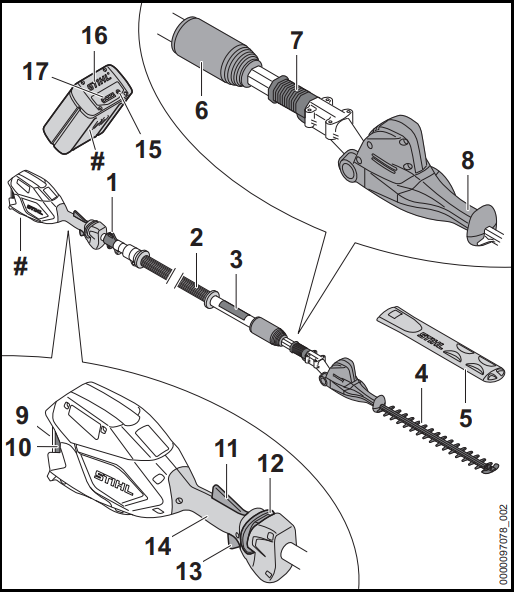
- Carrying Ring
For connecting a harness to the hedge trimmer. - Front Handle
Handle for the operator's front hand. - Drive Tube
Hedge trimmer shaft. - Cutting Blades
Steel blades for cutting hedges, shrubs and bushes. - Blade Scabbard
Covers the cutting blades to reduce the risk of injury from inadvertent contact during transportation and storage. - Clamping Nut
For adjusting the length of the drive tube. - Blade Adjustment Release
Unlocks the cutting blades to allow angle adjustment. - Blade Adjustment Grip
Used to set the cutting blades to the desired angle. - Battery Compartment
Holds the battery. - Locking Lever
Secures the battery in the battery compartment. - Ergo-Lever
Holds the retaining latch in the unlocked position. - Retaining Latch
Locks/unlocks the trigger switch. - Trigger Switch
Switches the motor on and off. - Control Handle
Handle for the operator's rear hand. - Push Button
Activates the battery's LEDs. - Battery
Supplies electrical power to the motor. - Battery LEDs
Indicate the battery's state of charge and display error messages regarding potential malfunctions in the battery or power tool.
Rating Plate
Contains electrical information and the product's serial number.
Detailed Specifications
STIHL HLA 86
- Approved battery types:
- STIHL AP series
- STIHL AR series
- Weight without battery: 10.6 lbs. (4.8 kg)
- For technical information regarding the STIHL AP and AR / AR L series batteries, see the product information accompanying your battery.
- For technical information regarding the STIHL AL 101, 300 and 500 series chargers, see the product information accompanying your charger.
- Batteries, chargers and other accessories sold separately.
- Contact your authorized STIHL servicing dealer for pricing and availability.
- Cutting Blades
- Tooth spacing: 1.3 in. (33 mm)
- Cutting length: 19.7 in. (500 mm)
- Sharpening angle: 45°
Description
The Stihl HLA 86 hedge trimmer stands out for its robust build and advanced features. The double-sided cutting blade is designed for efficient cutting and can handle thick branches with ease. The tool-free adjustment mechanism allows users to quickly adjust the blade angle, ensuring optimal performance in various cutting positions. The ergonomic design includes a comfortable grip and balanced weight distribution, reducing user fatigue.
Inserting and Removing the Battery
Inserting the Battery
To insert the battery:
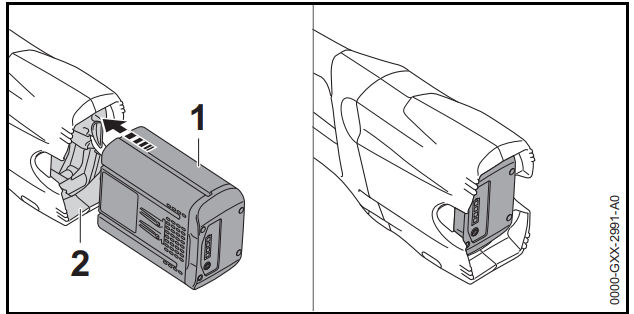
- Place the hedge trimmer on a level surface.
- Insert the battery (1) into the battery compartment (2) until it stops.
The battery is properly inserted when you hear an audible click. In this position, there is electrical contact between the battery and the hedge trimmer.
Removing the Battery
WARNING: To reduce the risk of severe personal injury from unintended activation, always remove the battery before assembling, transporting, adjusting, cleaning, servicing, maintaining or storing the hedge trimmer, and any other time it is not in use.
WARNING: Use care when ejecting the battery to prevent it from falling and causing personal injury or property damage.
To remove the battery:
- Release the trigger switch.
- Place the hedge trimmer on a level surface.
- Position your hand behind the battery.
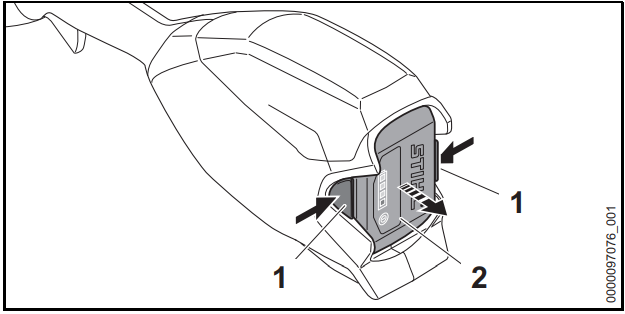
NOTICE: Avoid exposing the battery to excessive heat or prolonged periods of direct sunlight. Use or storage outside the recommended ambient temperature range can reduce the performance and/or service life of the battery.
Switching the Hedge Trimmer On and Off
Switching On
Before switching on:
- Make sure you have a secure and firm footing.
- Stand upright.
- Always hold and operate the hedge trimmer with one hand firmly on the control handle and the other hand firmly on the loop handle or front handle.
To switch the hedge trimmer on:
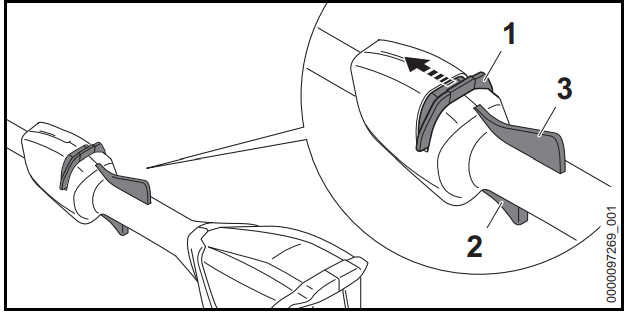
- Unlock the retaining latch (1) by pushing it forward with your thumb. Hold it in this unlocked position.
- While holding the retaining latch, squeeze the trigger switch (2) with your index finger.
The cutting blades will start moving.
The motor will not switch on unless the retaining latch is pushed forward and the trigger switch is pressed at the same time. Once the trigger switch is activated, you may release the retaining latch. Holding the Ergo-Lever (3) down keeps the trigger switch unlocked. The further the trigger switch is depressed, the faster the cutting blades will operate.
If you release the trigger switch and Ergo-Lever, you have to unlock the tool again with the retaining latch.
Switching Off
WARNING: To reduce the risk of personal injury from unintended activation or unauthorized use, switch off the motor and remove the battery before transporting or putting the hedge trimmer down.
To switch the hedge trimmer off:
- Release the trigger switch and Ergo-Lever so that the trigger switch springs back to the locked position. In the locked position, activation of the trigger switch is once again blocked by the retaining latch.
Checking the Controls
Testing the Controls
Before starting work, confirm that the retaining latch (1), trigger switch (2) and the Ergo-Lever (3) are undamaged and functioning properly.
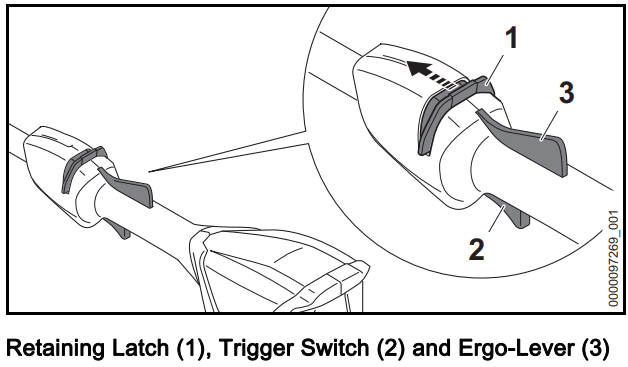
To test the controls:
- Remove the battery.
- Attempt to depress the trigger switch.
- If the trigger switch can be depressed without first unlocking the retaining latch, take the hedge trimmer to an authorized STIHL servicing dealer to be repaired before use.
- Press down on the Ergo-Lever. Make sure it moves freely and springs back into place when released.
- Unlock the retaining latch by pushing it forward.
- When you release the retaining latch it should return to the locked position.
- Unlock the retaining latch and depress the Ergo-Lever at the same time to keep the retaining latch unlocked. When you release the retaining latch, it should remain unlocked as long as you hold down the Ergo-Lever.
- Release the retaining latch and Ergo-Lever.
- Insert the battery.
- Hold the hedge trimmer firmly with one hand on the control handle and with the other hand firmly on the front handle or loop handle. While pushing the retaining latch forward, squeeze the trigger switch with your index finger.
- The hedge trimmer should switch on. If it does not, take the hedge trimmer to an authorized STIHL servicing dealer to be repaired before use.
- Release the trigger switch.
- The hedge trimmer should switch off.
- If the hedge trimmer does not switch off after you release the trigger switch, remove the battery and take the hedge trimmer to an authorized STIHL servicing dealer to be repaired before use.
During Operation
Adjusting the Angle of the Cutting Blades
To adjust the angle of the cutting blades:
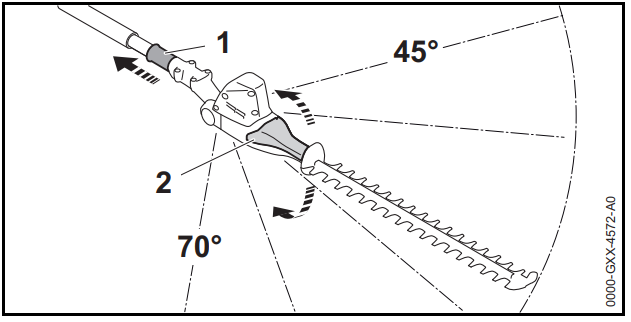
- Hold the blade adjustment grip (2) firmly.
- Pull back the blade adjustment release (1) and hold it in this unlocked position.
- Move the cutting blades to the desired angle.
- Release the blade adjustment release.
- The blade adjustment release will spring back into place.
- Move the blade adjustment grip up and down until the cutting blades engage.
- That completes the adjustment.
- Confirm that the blade adjustment grip is fixed in place.
Adjusting the Length of the Drive Tube
(HLA 86 only)
WARNING: To reduce the risk of injury from loss of control, ensure that the drive tube is properly adjusted and engaged in the locked position before starting work. The length of the drive tube can be adjusted to suit the height and reach of the operator.
To adjust the length of the drive tube:
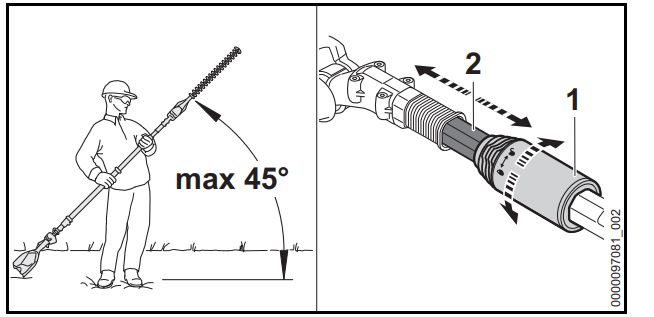
- Hold the hedge trimmer no more than 45° from the horizontal plane (see illustration).
- Unlock the drive tube (2) by turning the clamping nut (1) a half turn in the direction .
- Adjust the drive tube length by sliding it into the desired position.
- Lock the drive tube by turning the clamping nut in the direction and tightening it.
- Confirm that the drive tube is fixed in place
- If the drive tube still can be moved: Lock the drive tube by turning the clamping nut in the direction and tightening it until the drive tube is fixed in place.
Putting on and Adjusting the Shoulder Strap
To fit and adjust the harness:
Adjust the length of the shoulder strap (1) so that the carabiner (2) is about a hand’s width below the top of your hip.

Attach the carabiner (1) to the carrying ring (2) on the hedge trimmer.
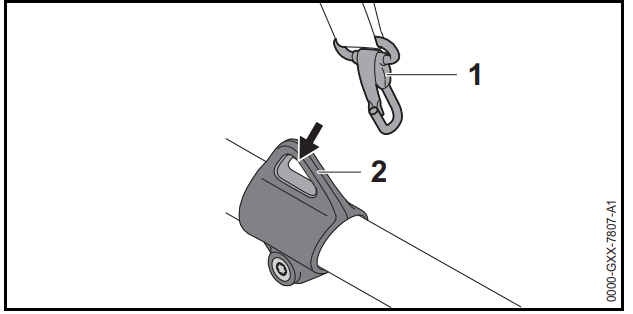
Using the Hedge Trimmer
WARNING: To avoid serious or fatal injury, avoid contact with the moving cutting blades. Never hold the material to be cut. Never remove cut material without first releasing the trigger
- Before starting work with the hedge trimmer, remove thick branches with a hand pruning saw, loppers, chain saw or other appropriate tool.
- Do not cut stems, branches or other vegetation greater than 1.3 in. (33 mm) in diameter.
Observe all applicable laws, regulations, standards and ordinances.
Cutting at ground level

- Set the cutting attachment to a suitable angle.
- Move the hedge trimmer back and forth, keeping the cutting blades parallel to the ground.
- Walk slowly and steadily forwards.
- If cutting performance deteriorates: Sharpen the cutting blades.
Cutting side of the hedge
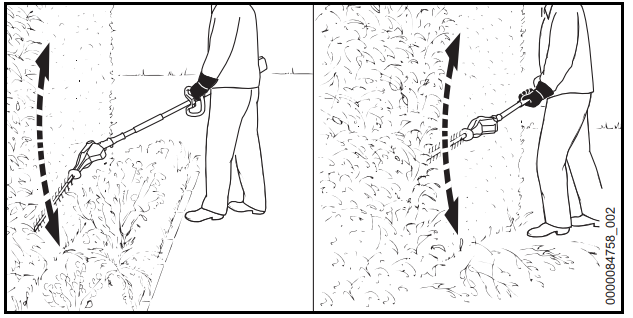
- If you have to cut at a certain distance from the hedge (flowerbed): Set the cutting attachment to a suitable angle.
- Swing the cutting attachment from the bottom of the hedge upwards in a controlled arc (see illustration above).
- Lower the nose of the cutting attachment, move along the hedge and swing the cutting attachment up again in a controlled arc.
- Cut the other side of the hedge in the same way.
- If cutting performance deteriorates: Sharpen the cutting blades.
Cutting the top of the hedge
- Hold the cutting attachment at an angle of 0° to 10° as you move the cutting attachment horizontally, using both sides of the cutting attachment (see illustration above).
- If cutting performance deteriorates: Sharpen the cutting blades.
Cutting overhead
WARNING: Working above shoulder height can be tiring. To reduce the risk of injury from fatigue, never hold the machine with your rear hand on the control handle above shoulder height. Set the adjustable cutter blades to the most suitable angle so that the unit can be held at a lower, less tiring position while providing adequate reach. Take frequent breaks.
- Set the cutting attachment to a suitable angle.
- Hold the cutting attachment at an angle of 0° to 10° as you move the cutting attachment horizontally, using both sides of the cutting attachment (see illustration above).
- If cutting performance deteriorates: Sharpen the cutting blades.
After Finishing Work
Preparing for Transportation or Storage
WARNING: To reduce the risk of personal injury from unintended activation or unauthorized use, switch off the motor, ensure the cutting blades have stopped and remove the battery before transporting the hedge trimmer or putting it down.
To prepare the hedge trimmer for transportation or storage:
- Switch off the hedge trimmer,
- Remove the battery,
- For a hedge trimmer with adjustable shaft, adjust the shaft to its shortest length,
- Slide a blade scabbard over the cutting blades so that it covers the entire cutting attachment.
- If the hedge trimmer or battery became wet during operation, allow them to dry completely before charging or storing.
Transporting the Hedge Trimmer and Battery
Hedge Trimmer
WARNING: Cover the entire length of the cutting blades with a blade scabbard before transporting or storing the hedge trimmer to reduce the risk of cut injuries from inadvertent contact.
When transporting the hedge trimmer:
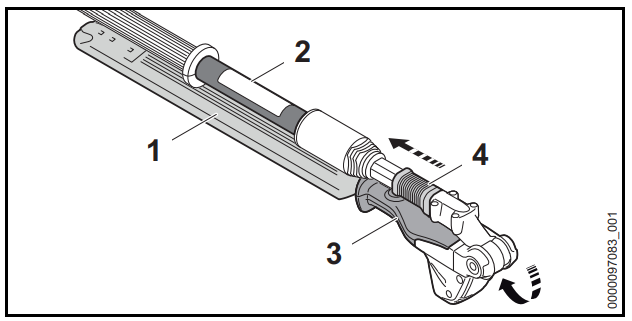
- Slide a blade scabbard over the cutting blades so that it covers the entire cutting attachment.
- Pull back the blade adjustment release (4) and hold it in this position.
- Hold the hedge trimmer at the blade adjustment grip (3) and fold the cutting blades (1) down completely until the cutting blades are parallel to the drive tube (2).
- Let go of the blade adjustment release.
- When the blade adjustment release reaches the transporting position, you will hear an audible click. The cutting attachment should be fixed in place and flush against the housing.
- When transporting the hedge trimmer by hand, hold it by the drive tube with the cutting blades pointing backwards, opposite the direction in which you are walking.
- When transporting the hedge trimmer in a vehicle, cover the entire length of the cutting blades with a blade scabbard. Secure and position the hedge trimmer to prevent turnover, impact and damage.
Your hedge trimmer comes standard with a blade scabbard.
Battery
WARNING
When transporting the battery:
- Place the battery in a non-metal container or carton and secure it against impact or damage. Never transport the battery in a metal or other container that is capable of conducting electricity, or near metal objects (e.g., paper clips, nails, coins, keys).
- If you are transporting the battery in a vehicle, secure it and its container to prevent turnover, impact and damage.
- STIHL batteries comply with the requirements set forth in UN-Manual ST/SG/AC.10/11/Rev.5/Part III, Subsection 38.3.
- Commercial air, vessel and ground transportation of lithium ion cells and batteries is regulated. The battery is classified as a UN 3480, Class 9, packaging group II product. Shipping it, either as a complete tool or the battery, requires compliance with all applicable shipping regulations. Check with the ground, vessel, air cargo or passenger airline to determine if transport is prohibited or subject to restrictions or exemptions prior to shipping or travel.
- Normally, no further conditions have to be met by the user in order to transport STIHL batteries by road to the power tool's operating site. Check and comply with any special regulations that may apply to your situation.
Setup Guide
- Assembly: Attach the blade to the trimmer head by aligning the pins and securing it firmly. Ensure all parts are properly locked in place.
- Pairing with Battery: Insert the compatible battery into the trimmer's battery compartment until it clicks into place.
- Configuration: Adjust the cutting blade angle using the tool-free mechanism.
- Operation: Hold the trimmer comfortably with both hands, ensuring proper balance and control. Start the trimmer by pressing the trigger switch while holding the safety switch.
Inspection and Maintenance
Inspecting and Maintaining the Hedge Trimmer
To properly maintain the hedge trimmer:
- Sharpen the cutting blades.
- Have the gearbox lubricated every 50 hours of operation by an authorized STIHL servicing dealer.
- Have worn or damaged cutting blades replaced by an authorized STIHL servicing dealer.
- Have worn, missing or damaged safety labels replaced by an authorized STIHL servicing dealer.
If you make a warranty claim for a component that has not been serviced or maintained properly, coverage may be denied.
Inspecting and Maintaining the Cutting Blades
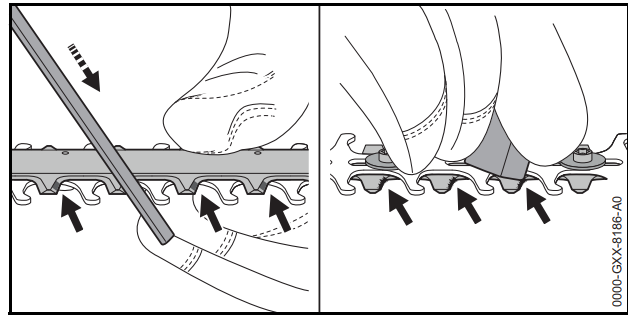
WARNING
To reduce the risk of personal injury from unintended activation, remove the battery before inspecting the cutting blades or carrying out any maintenance, To help prevent injuries, always wear heavy-duty work gloves when handling the hedge trimmer or its cutting blades, STIHL recommends having the cutting blades sharpened by an authorized STIHL servicing dealer.
Although it is best to have the cutting blades sharpened by a dealer on a workshop sharpener, it is possible to use a flat crosscut sharpening file. Sharpen the cutting blades when cutting performance begins to deteriorate, i.e., blades frequently snag on branches or fail to cut material cleanly.
To sharpen the cutting blades with a file:
- Sharpen each cutting edge of the upper cutting blade with a sharpening file. Always file toward the cutting edge with a forward motion matching the sharpening angle, Sharpen on the forward stroke. Lift off the blade on the backstroke.
- Only sharpen the cutting edges. Do not file blunt projecting parts of the cutting attachment, or the cutting blade guard. Make sure your sharpening stroke matches the sharpening angle,
- Turn the hedge trimmer over.
- Use a whetstone to remove any burrs from the cutting edges. Remove as little material as possible.
- After sharpening, wipe away filing or grinding dust with a dry or slightly dampened cloth and then spray the cutting blades with a resin solvent, such as STIHL Resin Remover and Lubricant.
NOTICE: Operating the machine with dull or damaged cutting blades may overload the motor. Keeping the cutting blades sharp helps maintain cutting performance and the expected life of the product.
Maintenance, Repair and Storage
Warnings and Instructions
WARNING
- There are no user-authorized repairs for the hedge trimmer, battery or charger. To reduce the risk of fire, electric shock or other personal injury and property damage:
- Users may carry out only the cleaning and maintenance operations described in this manual.
- Strictly follow the cleaning and maintenance instructions in the appropriate sections of this instruction manual.
- STIHL recommends that all repair work be performed by authorized STIHL servicing dealers.
- Unintentional starting may result in personal injury or property damage. To reduce the risk of personal injury and property damage from unintentional starting:
- Remove the battery before inspecting the hedge trimmer or carrying out any cleaning, maintenance or repair work, before storing, and any other time the hedge trimmer is not in use.
- The cutting blades are the only user-serviceable parts of the hedge trimmer. Proper maintenance will help maintain cutting performance and reduce the risk of personal injury.
- Wear heavy-duty non-slip work gloves when handling the cutting blades.
- Keep the cutting blades clean and sharp.
- Tighten all nuts, bolts and screws after each use.
- Never attempt to repair damaged cutting blades by welding, straightening or modifying the shape. This may cause parts of the cutting blades to experience uneven or excessive wear or other damage that can lead to a malfunction or breakage during operation, resulting in serious or fatal injuries.
- Use of parts that are not authorized or approved by STIHL may cause serious or fatal injury or property damage.
- STIHL recommends that only identical STIHL replacement parts be used for repair or maintenance.
- To reduce the risk of short circuit and fire:
- Keep the battery guides free of foreign matter. Clean as necessary with a dry cloth or soft, dry brush.
- Improper storage can result in unauthorized use, damage to the hedge trimmer and battery and charger, and an increased risk of fire, electric shock and other personal injury or property damage.
- Remove the battery from the hedge trimmer before storing.
- Never store the hedge trimmer or charger with the battery inserted.
- Store the hedge trimmer and battery and charger indoors in a dry, secure place that cannot be accessed by children or other unauthorized users.
- Never store the battery in the hedge trimmer, in the charger, in a metal container or in a container with metal objects (e.g., paper clips, nails, coins, keys).
- To reduce the risk of electric shock and other personal injury or property damage when mounting the charger and wall bracket:
- Ensure that no electrical cables, pipes or other service lines run behind the wall where the charger and wall bracket is to be mounted.
- Mount the charger and wall bracket only as described in this manual.
Charging the Battery
Setting up the Charger
WARNING: Read and follow the safety precautions on the battery and charger and all warnings and instructions that accompany those products. To reduce the risk of short circuit, which could lead to electric shock, fire and explosion, make sure the charger and its components are dry and not damaged; operate the charger indoors at an appropriate ambient temperature.
WARNING: A typical household electric circuit is between 15 and 20 amps. A single STIHL AL 500 charger draws approximately 4.8 amps. A single AL 300 charger draws approximately 4.4 amps. To reduce the risk of fire from overloading an electrical circuit:
- Ensure the electrical system is rated to withstand the expected electrical draw before charging your battery.
- Charge multiple batteries one at a time or on separate circuits, unless you know your circuit can handle the total expected draw from multiple chargers.
WARNING: Since the charger heats up during the charging process, do not operate the charger on a combustible surface or in a location where combustible gases, liquids, vapors, dusts or other materials and substances are present.
To set up the charger:

The charger runs a self-test immediately after it is plugged in. The charger LED (1) will glow green for about 1 second, then it will glow red briefly before going out. Once the LED goes out, the self-test is complete and the charger is ready to charge the battery.
- Position the power supply cord (2) so that it will not be stepped on, tripped over, come in contact with sharp objects or moving parts or otherwise be subjected to damage or stress.
Charging
WARNING
- STIHL batteries contain safety features and devices which, if damaged, may allow the battery to generate heat, rupture, leak, ignite or explode. Never charge a malfunctioning, damaged, cracked, leaking or deformed battery, or use a charger that has been damaged. Never insert a wet battery or battery adapter. Never use a wet charger. Follow all product-specific warnings and instructions accompanying your battery and charger.
- A battery is not fully charged when it ships from the factory. STIHL recommends that you fully charge the battery before using it the first time.
- Operate the charger only indoors, in dry rooms and within an ambient temperature range of 41 °F to 104 °F (5 °C to 40 °C).
- The battery heats up during operation of the power tool. If a hot battery is connected to the charger, it may be necessary for it to cool down before charging starts. The charging process begins only after the battery has cooled down sufficiently.
- Charging time depends on a number of factors, including battery condition and the ambient temperature. For a complete list of approximate charging times, see https://www.stihl.com/charging-times
To charge an AR battery:

- Push the plug of the connecting cord (1) into the socket (2) of the AP Adapter (3) until it stops.
- Push the AP Adapter into the charger (5) until it stops. The LED on the charger (4) glows green when the battery is charging.
- The LEDs on the AR battery glow green and show the state of charge.
- When the LEDs on the battery turn off, the charging process is complete and the charger will shut itself off. The AP Adapter can be removed from the charger.
- Disconnect the power supply cord from the electrical outlet when the charger is not in use for extended periods of time.
- Charge STIHL AR backpack batteries only with genuine STIHL AL 300 or AL 500 series chargers.
To charge an AP battery:
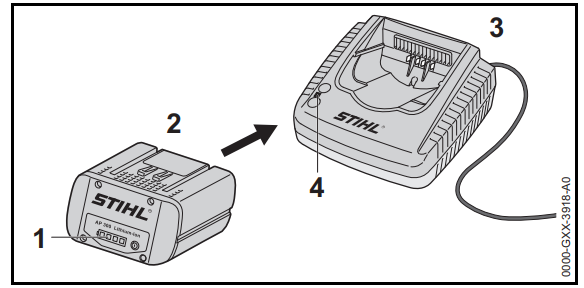
- Push the battery (2) into the charger (3) until it stops. The LED on the charger glows green when the battery is charging.
- The LEDs (1) on the AP battery glow green and show the state of charge.
- When the LEDs on the battery go out, the charging process is complete and the charger will shut itself off. The AP battery can be removed from the charger.
- Disconnect the power supply cord from the electrical outlet when the charger is not in use.
- Charge STIHL AP series batteries only with genuine STIHL AL 101, AL 300 or AL 500 series chargers.
General Power Tool Safety Warnings
WARNING
- Read all safety warnings, instructions, illustrations and specifications provided with this power tool. Failure to follow all instructions listed below may result in electric shock, fire and/or serious injury.
- Save all warnings and instructions for future reference.
The term "power tool" in the warnings refers to your mains-operated (corded) power tool or battery-operated (cordless) power tool.
Work Area Safety
- Keep work area clean and well lit. Cluttered or dark areas invite accidents.
- Do not operate power tools in explosive atmospheres, such as in the presence of flammable liquids, gases or dust. Power tools create sparks which may ignite the dust or fumes.
- Keep children and bystanders away while operating a power tool. Distractions can cause you to lose control.
Electrical Safety
- Power tool plugs must match the outlet. Never modify the plug in any way. Do not use any adapter plugs with earthed (grounded) power tools. Unmodified plugs and matching outlets will reduce the risk of electric shock.
- Avoid body contact with earthed or grounded surfaces, such as pipes, radiators, ranges and refrigerators. There is an increased risk of electric shock if your body is earthed or grounded.
- Do not expose power tools to rain or wet conditions. Water entering a power tool will increase the risk of electric shock.
- Do not abuse the cord. Never use the cord for carrying, pulling or unplugging the power tool. Keep cord away from heat, oil, sharp edges or moving parts. Damaged or entangled cords increase the risk of electric shock.
- When operating a power tool outdoors, use an extension cord suitable for outdoor use. Use of a cord suitable for outdoor use reduces the risk of electric shock.
- If operating a power tool in a damp location is unavoidable, use a residual current device (RCD) or ground fault circuit interruptor (GFCI) protected supply. Use of an RCD or GFCI reduces the risk of electric shock.
Personal Safety
- Stay alert, watch what you are doing and use common sense when operating a power tool. Do not use a power tool while you are tired or under the influence of drugs, alcohol or medication. A moment of inattention while operating power tools may result in serious personal injury.
- Use personal protective equipment. Always wear eye protection. Protective equipment such as dust mask, non-skid safety shoes, hard hat, or hearing protection used for appropriate conditions will reduce personal injuries.
- Prevent unintentional starting. Ensure the switch is in the off-position before connecting to power source and/or battery pack, picking up or carrying the tool. Carrying power tools with your finger on the switch or energizing power tools that have the switch on invites accidents.
- Remove any adjusting key or wrench before turning the power tool on. A wrench or a key left attached to a rotating part of the power tool may result in personal injury.
- Do not overreach. Keep proper footing and balance at all times. This enables better control of the power tool in unexpected situations.
- Dress properly. Do not wear loose clothing or jewellery. Keep your hair and clothing away from moving parts. Loose clothes, jewellery or long hair can be caught in moving parts.
- If devices are provided for the connection of dust extraction and collection facilities, ensure these are connected and properly used. Use of dust collection can reduce dust-related hazards.
- Do not let familiarity gained from frequent use of tools allow you to become complacent and ignore tool safety principles. A careless action can cause severe injury within a fraction of a second.
Power Tool Use and Care
- Do not force the power tool. Use the correct power tool for your application. The correct power tool will do the job better and safer at the rate for which it was designed.
- Do not use the power tool if the switch does not turn it on and off. Any power tool that cannot be controlled with the switch is dangerous and must be repaired.
- Disconnect the plug from the power source and/or remove the battery pack, if detachable, from the power tool before making any adjustments, changing accessories, or storing power tools. Such preventive safety measures reduce the risk of starting the power tool accidentally.
- Store idle power tools out of the reach of children and do not allow persons unfamiliar with the power tool or these instructions to operate the power tool. Power tools are dangerous in the hands of untrained users.
- Maintain power tools and accessories. Check for misalignment or binding of moving parts, breakage of parts and any other condition that may affect the power tool's operation. If damaged, have the power tool repaired before use. Many accidents are caused by poorly maintained power tools.
- Keep cutting tools sharp and clean. Properly maintained cutting tools with sharp cutting edges are less likely to bind and are easier to control.
- Use the power tool, accessories and tool bits etc. in accordance with these instructions, taking into account the working conditions and the work to be performed. Use of the power tool for operations different from those intended could result in a hazardous situation.
- Keep handles and grasping surfaces dry, clean and free from oil and grease. Slippery handles and grasping surfaces do not allow for safe handling and control of the tool in unexpected situations.
IMPORTANT SAFETY INSTRUCTIONS
Intended Use
WARNING
- This hedge trimmer is designed for trimming hedges, shrubs and bushes in yards and gardens. Use of the hedge trimmer for operations different than intended could result in serious injury or death.
- Improper use could result in personal injury or property damage, including damage to the hedge trimmer.
- Use the hedge trimmer and battery only as described in this manual.
- Never attempt to modify or override the hedge trimmer's controls or safety devices in any way.
- Never use a hedge trimmer that has been modified or altered from its original design.
- Be sure to read and follow the warnings and instructions for your battery and charger before charging or starting work.
- This power tool may be powered by a STIHL AP series battery. Alternatively, it may be powered by a STIHL AR series backpack battery in combination with an AP Adapter.
Batteries, chargers and other accessories are sold separately.
Operator
WARNING
- Working with the hedge trimmer can be strenuous. The operator must be in good physical condition and mental health. To reduce the risk of personal injury from fatigue and loss of control:
- Check with your doctor before using the hedge trimmer if you have any health condition that may be aggravated by strenuous work.
- Do not operate the hedge trimmer while under the influence of any substance (drug, alcohol or medication, etc.) that might impair vision, balance, dexterity or judgment.
- Be alert. Do not operate the hedge trimmer when you are tired. Take a break if you become tired.
- Do not permit minors to use the hedge trimmer.
- According to STIHL's current knowledge, the electric motor of this hedge trimmer should not interfere with a pacemaker.
- However, persons with a pacemaker or other implanted medical device should consult their physician and device manufacturer before operating this hedge trimmer.
Troubleshooting Guide
Hedge Trimmer and Battery
Always remove the battery before carrying out any inspection, cleaning or maintenance.
| Condition | LEDs on Battery | Cause | Remedy |
|---|---|---|---|
| Hedge trimmer does not start when switched on. | No electrical contact between hedge trimmer and battery. | Remove the battery. Visually check the electrical contacts in the battery compartment and on the battery. Reinsert the battery. | |
| 1 LED flashes green | Battery has low charge. | Charge the battery. | |
| 1 LED glows red | Battery too hot / too cold. | Allow the battery to warm up or cool down gradually at ambient temperatures of about 50 °F to 68 °F (10 °C to 20 °C). | |
| 4 LEDs flash red | Malfunction in battery. | Remove the battery and reinsert it. Switch on the hedge trimmer. If the LEDs continue to flash, do not use. Replace the battery. | |
| 3 LEDs glow red | Hedge trimmer too hot. | Allow the hedge trimmer to cool down. | |
| 3 LEDs flash red | Malfunction in hedge trimmer. | Remove the battery and reinsert it. Switch on the hedge trimmer. If the LEDs still flash, have the hedge trimmer checked by a servicing dealer. |
| Condition | LEDs on Battery | Cause | Remedy |
|---|---|---|---|
| Cutting blades are not clean and lubricated. | Cutting blades are not clean and lubricated. | Clean the cutting blades. If the LEDs still flash, do not use. Have the hedge trimmer checked by a servicing dealer. | |
| Hedge trimmer cuts out during operation. | 1 LED glows red | Battery too hot / too cold. | Remove the battery. Allow the hedge trimmer and battery to cool down gradually at ambient temperatures of about 50 °F to 68 °F (10 °C to 20 °C). |
| 3 LEDs glow red | Hedge trimmer too hot. | Allow the hedge trimmer to cool down. | |
| Run-time is too short. | Battery not fully charged. | Charge the battery. | |
| Useful life of battery has been reached or exceeded. | Have the battery checked by an authorized STIHL servicing dealer. | ||
| Battery is not being charged even though LED on charger glows green. | 1 LED glows red | Battery too hot / too cold. | Allow the battery to warm up or cool down gradually at ambient temperatures of about 50 °F to 68 °F (10 °C to 20 °C). Operate the charger only in enclosed, dry rooms at ambient temperatures of 41 °F to 104 °F (5 °C to 40 °C). |
Stihl Hedge Trimmer HLA-86Warranty
STIHL Incorporated Limited Warranty Policy
This product is sold subject to the STIHL Incorporated Limited Warranty Policy, available at https://www.stihlusa.com/warranty.html
Pros & Cons
Pros
- High-Torque Motor: Efficient cutting performance even through thick branches.
- Cordless Convenience: Freedom from cords with long-lasting battery life.
- Ergonomic Design: Reduced user fatigue due to balanced weight distribution.
- Tool-Free Adjustment: Easy adjustment of cutting blade angle without tools.
- Quiet Operation: Lower noise levels compared to gas-powered trimmers.
Cons
- Battery Cost: Additional cost for batteries if not purchased as part of a kit.
- Limited Cutting Length: May require multiple passes for very long hedges.
- Weight with Battery: Slightly heavier than some other cordless trimmers when equipped with battery.
Customer Reviews
The Stihl HLA 86 has received positive feedback from users for its powerful performance, ease of use, and durability. Many reviewers appreciate the convenience of cordless operation and the tool-free adjustment feature. However, some users note that it can be slightly heavier when equipped with a battery and that additional battery costs should be considered.
Most Common Complaints
- Higher initial cost compared to other trimmers on the market.
- Some users find it heavier than expected when fully assembled with a battery.
Faqs
How long does the battery last on the Stihl Hedge Trimmer HLA-86?
Is the Trimmer suitable for thick branches?
How do I adjust the cutting blade angle on the HLA 86?
What safety precautions should I take when using the Hedge Trimmer?
How do I maintain my Stihl Hedge Trimmer?
Can I use the Stihl Hedge Trimmer for commercial purposes?
How much does the Trimmer weigh?
Where can I purchase replacement parts for my Stihl Hedge Trimmer?
Leave a Comment
